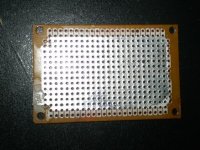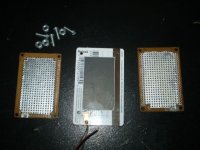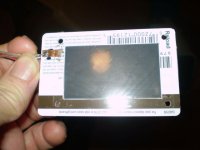here is a link, i dont use the same gun but you will get the idea.
YouTube - High Pressure Spray On Bedliner DEMO
just checked the link, should work.the matarial is polyurethane based, does not deform the metal in any way, the catalist is what makes it dry so fast. check out the video.
YouTube - High Pressure Spray On Bedliner DEMO
just checked the link, should work.the matarial is polyurethane based, does not deform the metal in any way, the catalist is what makes it dry so fast. check out the video.
i used polyurethane on my very first panel and i use it for any thing hv like tesla coils and stuff.i found out the hard way not spray enamel on poly as it wiil cause it to bubble and peel especialy with a heavy wet coat.i think, if i'm remembering correctly on the bigger panels the first coating was poly and i hand painted it and it took forever,i tried dipping but that just plugged up the holes in the screen .one coat was not enough so i side screw that and used spray paint .once i got 3 or 4 light coats on, letting them cure a day or two in between then i could apply heavier coats without dissolving the base coat of poly .oh trust me i was at the end of my patience then, believe me ! thats when i discovered powder coating and talked to roger sanders and got some of his suggestions.then i got got lucky and found a powder coating company in town.i explained to him what i was doing and he agreed to do afew samples to see if it worked and it did .those are the little black ones in the pics.if you notice they are 1/4 the size of the big ones.i was going to do a comparison test of surface area with the same drive level but never got that far.it should be either 6db or 12 db difference i'll ihave to look it up but i think its 6db.however i believe i noticed more openness or airy type of quality with the black ones over the large white ones which could be due to the larger open area although there was no coloration and they both sounded great i think it has to do with the dampening of the diagphram. quite posisably what i'm hearing in my tiny driver.this is (one of) something a had planned to do research on back then and i'm planning to do in the (hopefuly) near future.jer
I have to say that I have put alot of time in making sure this is done right the first time. Charlie has done more than 3/4 with demonstration of his own hybrid sysyem. I really now just need to know what % the panel shold be, 51% or higher??? and the hole diameter. My luck, it will be tradititional coating, but reading Sander's book, try and use what is readilly available and viable, err go, rhino coating.
If i screw up 400 dollors worth the metal, that will end this, if i succeed, then there is really something here to talk about.
the specefics are so hard to say as there are too many variables and franky i do not know how to describe them, i can only tell that i can do it, have allready done it. just not on this material, i used something lying around the shop, which i drilled holes on or in the metal, light spray and tested thickness, which was around 15-20 mills on one pass of spray at 15 feet away. the holes never showed any sighn of clogging or build up, very smooth and shiney.
So i will leave the question to the pro's, is 51% with a slightly larger hole the way to go, I can allways spray again very fast to achieve thie thickness and keep the same or close to ope area on the panels. Suggestions please.
If i screw up 400 dollors worth the metal, that will end this, if i succeed, then there is really something here to talk about.
the specefics are so hard to say as there are too many variables and franky i do not know how to describe them, i can only tell that i can do it, have allready done it. just not on this material, i used something lying around the shop, which i drilled holes on or in the metal, light spray and tested thickness, which was around 15-20 mills on one pass of spray at 15 feet away. the holes never showed any sighn of clogging or build up, very smooth and shiney.
So i will leave the question to the pro's, is 51% with a slightly larger hole the way to go, I can allways spray again very fast to achieve thie thickness and keep the same or close to ope area on the panels. Suggestions please.
i guess we need to know what the exact holes size and hole spacing that you are constdering to use. that will give us a better idea of helping you to choose.imo i would go with 51% depending on the hole size.i haven't checked with your source yet on what is available,but i wiil make a piont to do so tonight meanwhile post the info on the material your wanting to use and i'll look it up and give you my thoughts.now if i remember correctly roger had told that if the final open area is anywhere between like 42% to 60% or 65% it would be ok providing that the holes are not to large say like 1/4" or 3/8" for example as holes this size would severly reduce the efficiancy of the panel .now the diference in sound i heard on my panels was very very slight and would never have noticed until i had a&b them.this is something that needs to be tested in a controled situation and there many many discussions on this .now to make things a little easier for you there are some basic guide lines the first and fore most what are the exact dimensions of the panel you are planning?2 will they be segmented or not?let's start with that even though i have not read or gotten a copy of roger's book (i plan to do so) i pretty much know what the guidelines are .then also by your reading of the book we could determin if were following the proper direction.i know it is an overwhelming supply of what if's and that's (my thoughts also at the time),but the best advice gave he me was that "every thing is a compromise "for instance if you want lows (everybody does!) you need surface area if thats not an option then you need more spacing(d/s) doing that increases power requirements and bais voltage because of reduced effeciancy increaced bias means thicker coating which means bigger holes which means less static field and so on.the trick is to find a happy medium were it all works together .so i under stand your frustration.so lets lay down some ground rules(requirement) such as size ,we already have one that is 4 ohm load is optimum for your amps ,so size(most important above all) and material. jer
here are the expoded view pics of the tiny driver i had promised to post for you and everyone , wachara C. jer
Attachments
-
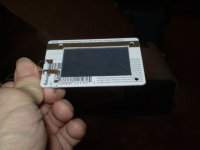 coated-side.jpg21 KB · Views: 402
coated-side.jpg21 KB · Views: 402 -
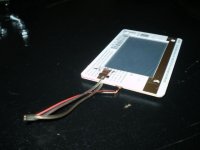 conections.jpg27.8 KB · Views: 392
conections.jpg27.8 KB · Views: 392 -
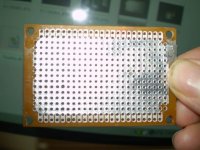 plugged-holes.jpg53.7 KB · Views: 396
plugged-holes.jpg53.7 KB · Views: 396 -
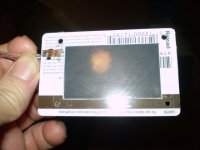 ripples.jpg30.6 KB · Views: 383
ripples.jpg30.6 KB · Views: 383 -
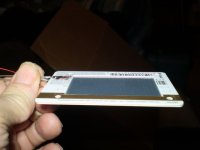 sandwhich2.jpg21.7 KB · Views: 380
sandwhich2.jpg21.7 KB · Views: 380 -
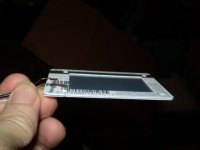 sandwhich.jpg18 KB · Views: 132
sandwhich.jpg18 KB · Views: 132 -
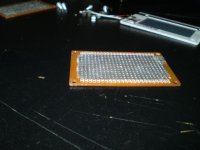 stator-closeup2.jpg37.2 KB · Views: 131
stator-closeup2.jpg37.2 KB · Views: 131 -
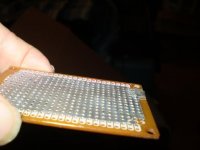 stator-closeup1.jpg29.3 KB · Views: 140
stator-closeup1.jpg29.3 KB · Views: 140 -
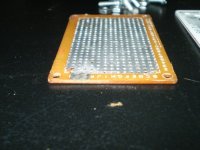 statorcloseup3.JPG49.9 KB · Views: 133
statorcloseup3.JPG49.9 KB · Views: 133
Hi Mavric,
I have tried a few hole patterns for the stators, and I like those with more open area better. The latest ones that I made were about at least 60% open area and with 6 millimeters hexagon holes. I think more open area stator has more openness in sound. However, it might be a little less efficient when compare to those with lesser open area.
If I were you, I would choose something that is easy to find. Hole size of around 3 millimeters with open area of around 40% or more should be good and shouldn't be too difficult to find.
I have tried a few hole patterns for the stators, and I like those with more open area better. The latest ones that I made were about at least 60% open area and with 6 millimeters hexagon holes. I think more open area stator has more openness in sound. However, it might be a little less efficient when compare to those with lesser open area.
If I were you, I would choose something that is easy to find. Hole size of around 3 millimeters with open area of around 40% or more should be good and shouldn't be too difficult to find.
wachara C. thank you for the complement.the coating on stator is common clear acrylic enamel and on the digphram used i used licron.it is all i have at the moment and it is what i used on the bigger panels.but my problem is the mylar is .1 mil without the coating (confrimed with a micrometer) with the coating it is about .2 or.3mil (with the latter being the closest average) which is what brought me back to diyaudio to see if there has been any innovative breakthroughs (in the last 7 years) on coating technology's,mavric's idea using rinho is one of them and the pva glue trick is another.now that they are apart i'm going to replace the digphram and try it.if the coating thickness results (as reported in another thread) is acheived ,then, i have some .06mil polyester i can try.jer
quote:"I have tried a few hole patterns for the stators, and I like those with more open area better. The latest ones that I made were about at least 60% open area and with 6 millimeters hexagon holes. I think more open area stator has more openness in sound.However, it might be a little less efficient when compare to those with lesser open area.
If I were you, I would choose something that is easy to find. Hole size of around 3 millimeters with open area of around 40% or more should be good and shouldn't be too difficult to find. " i have always wondered about ,if, such a large hole size would work well.imo for the sake of effiantecy anything larger than say 3/16" to 1/4" would be pushing the limits. although,however, i'm not saying it woudn't work,i personaly have not tried it and had planned to do research on this.i personaly would love to build some metal sheet stators my self as the are athseticly beutiful.but after seeing the prices (last night) of material it just brought me back to the realization of why i choose the construction i used.cheap and effective and still with great sound.now there is alot room for improvement for my design, i agree,such as(my biggest concern) panel viberations and such which can be remedied with some braces or just build a stronger suitable frame.hole size? i used window screen,my next step is to try 1/8" welded wire mesh but who's to say that the common 1/4" stuff you find in hardware store wouldn't work ethier .it has yet to be tried and some thing i had planned to do a long time ago,and the reasons i didn't yet, i have already explained earlier.so before you spend $$$$$ on some steel panels,may suggest to you to maybe building somthing smaller as a test first to see if the results are what you desire.that is how started on a very stirct budget and ended up with fabulous results.think about the weld wire technique is suggested as it is defintely a cheaper way to go and still acheiving the same high quality results.i would like some of your thoughts and views on this.jer
If I were you, I would choose something that is easy to find. Hole size of around 3 millimeters with open area of around 40% or more should be good and shouldn't be too difficult to find. " i have always wondered about ,if, such a large hole size would work well.imo for the sake of effiantecy anything larger than say 3/16" to 1/4" would be pushing the limits. although,however, i'm not saying it woudn't work,i personaly have not tried it and had planned to do research on this.i personaly would love to build some metal sheet stators my self as the are athseticly beutiful.but after seeing the prices (last night) of material it just brought me back to the realization of why i choose the construction i used.cheap and effective and still with great sound.now there is alot room for improvement for my design, i agree,such as(my biggest concern) panel viberations and such which can be remedied with some braces or just build a stronger suitable frame.hole size? i used window screen,my next step is to try 1/8" welded wire mesh but who's to say that the common 1/4" stuff you find in hardware store wouldn't work ethier .it has yet to be tried and some thing i had planned to do a long time ago,and the reasons i didn't yet, i have already explained earlier.so before you spend $$$$$ on some steel panels,may suggest to you to maybe building somthing smaller as a test first to see if the results are what you desire.that is how started on a very stirct budget and ended up with fabulous results.think about the weld wire technique is suggested as it is defintely a cheaper way to go and still acheiving the same high quality results.i would like some of your thoughts and views on this.jer
wachara C. thank you for the complement.the coating on stator is common clear acrylic enamel and on the digphram used i used licron.it is all i have at the moment and it is what i used on the bigger panels.but my problem is the mylar is .1 mil without the coating (confrimed with a micrometer) with the coating it is about .2 or.3mil (with the latter being the closest average) which is what brought me back to diyaudio to see if there has been any innovative breakthroughs (in the last 7 years) on coating technology's,mavric's idea using rinho is one of them and the pva glue trick is another.now that they are apart i'm going to replace the digphram and try it.if the coating thickness results (as reported in another thread) is acheived ,then, i have some .06mil polyester i can try.jer
Jer, I have never done this before as i have said. I will try my best to explain.
> prepping the panels, i know they will have a ruff cut on the back end, that is where the orbital sander comes in, i have to prep the surface, rremoving any unwanted material, its not sand paper, i call it a "scuffer", then denatured alchohol is used to clean any debris from the surface.
> This is my last concern. the hole diameter. i have been given metric and standard. the panels will be about 13" by 48" . since i can on only run 4 ohm max, this will be a hybrid, elctronic crossover for the panels at 500 hz. and powered servo subs with variable cross over to compensate low end. which i allready have, plenty.
>this is something i have not mentioned..... if for some reason the coating is not sonsistent or perfect, liquid nitrogen is sold here cheap. you just a container, wear some killler gloves and pour in the rhino, it will cause it to shrink and pop off the metal without any deformation to the metal, i say this because there are two different materials being used, mixed togther, heated to 200 degrees, and shot out a hole small than a pencil tip. I am rebuiding some components of the gun, that gun has just as many variables as these panels.
> geraldfryjr, please stay wih this, i want to post video as we all know a picture is worth 1000 words.
> thanks for your interest, as well, the stuff is flexable, so anyone making curved panels, you can spray if flat and bend it to about 30 degrees, pretty neat.
>it is super bowl weekend here. everyone drive safe, and i hope i gave a better description. I have a hard time putting on blogs or posts as i simply cannot type as fast i think.
once again, thanks for the interest, reading sander's book and chatting with Charlie is all i know about ESL's. as mentioned in his book, you can make these with material allready around you. so, why not. Mavric
wachara C. the reason i had come up with i the aluminium tape idea is becuase i could not find a source of predrilled un etched copper clad board material and the the ones that i did find that could have posibaly been made to work were extremly expenceive for this application.someday i plan to purchase or build machine like yours oneday.very impressive.jer
that machine cost alone 50k, I have experience in home, car, electrical wiring, the machine alone draws 100 amps @ 220volt.
let me put all my ideas aside, does anyone here or has anyone used what i have been trying best to explain? rhino lining has about 100 different applications, the one i use i cannot find any REAL pics or video, the one i posted looked like someone just going crazy with it, it can be very well controlled.
I am trying to keep the cost down on material, as said, use what you have around you, this will work, no promise but from years of spraying, i thought it would be the best and the fastest way to coat a panel that will last a life time, simple.
let me put all my ideas aside, does anyone here or has anyone used what i have been trying best to explain? rhino lining has about 100 different applications, the one i use i cannot find any REAL pics or video, the one i posted looked like someone just going crazy with it, it can be very well controlled.
I am trying to keep the cost down on material, as said, use what you have around you, this will work, no promise but from years of spraying, i thought it would be the best and the fastest way to coat a panel that will last a life time, simple.
don't worry i don't give up very easly ,not at all, in fact never!i like your idea and wish to see it through.as i have said in a post on a another thread which had been deleted(reasons i promised not to discuss)is, the word "can't" is not in my vocabulary and "impossible" is only because the technology hasn't been created yet.i just got a little worried when you said "If i screw up 400 dollors worth the metal, that will end this" .please don't give up reguardless.your on to somthing here.rhino had just came out back when i had discovered powder coating,and was not widely available ,or in my area at the time.i live in a industerial town and many many every day products and some high tech things are produced here,but not everyone has that advantage.with rinho being more and more widely spread than powder coating shops,it makes it a very viable alternative for diy'er and mass production,but for the diy'er especialy!so keep push'in on my friend.jer
the texture comes after you lay down your base coat. in other words, when spaying, you use about six coats to acheive the desiered thickness. texture comes from spraying into the air and as it falls there will fragments, ergo texture,
otherwise the first coat, is very smooth and glossy, you have to in a way of saying, make the bed of a truck as ugly as you can by texture, otherwise, the result is a very very shiny surface, first layer is at or around 15 mills.
MccMaster is who I going to order the panels from. On a personal issue, i have my anniversary next week, tax season, working 80 hrs. a week, and wanting this as well. ALOT on my mind.
thanks for pushing me, i hope it works and will be less inexpensive than powder coating. So if anyone reads this, spray some metal and tell me or us what you think.
powder coating is brittle, my approach is , you can hit this a hammer, expose it to UV ray, drag it down the road, and you might just scratch it, also, if you spay an uneven surface, you can still bend it back into shape without cracks and things of that nature.
I only said that as i was told that the perferated panels comes shipped sometimes bent or warped as well as having oil residue, which is still no prblem to clean, denatured alchohal, zylol, takes any residue off.
Today, the rhino gun will be rebuilt using a smaller nozel, smaller than the tip of a pencil.
and no, i will not give up, just need material. and some time. thanks for kick in the back to keep going. i allways think there might be a better way, so here we go, try and post again after work for results and pics of our setup, this way everyone knows what I am using and goals. this will all make sence when i post some pics. and its Monday,
otherwise the first coat, is very smooth and glossy, you have to in a way of saying, make the bed of a truck as ugly as you can by texture, otherwise, the result is a very very shiny surface, first layer is at or around 15 mills.
MccMaster is who I going to order the panels from. On a personal issue, i have my anniversary next week, tax season, working 80 hrs. a week, and wanting this as well. ALOT on my mind.
thanks for pushing me, i hope it works and will be less inexpensive than powder coating. So if anyone reads this, spray some metal and tell me or us what you think.
powder coating is brittle, my approach is , you can hit this a hammer, expose it to UV ray, drag it down the road, and you might just scratch it, also, if you spay an uneven surface, you can still bend it back into shape without cracks and things of that nature.
I only said that as i was told that the perferated panels comes shipped sometimes bent or warped as well as having oil residue, which is still no prblem to clean, denatured alchohal, zylol, takes any residue off.
Today, the rhino gun will be rebuilt using a smaller nozel, smaller than the tip of a pencil.
and no, i will not give up, just need material. and some time. thanks for kick in the back to keep going. i allways think there might be a better way, so here we go, try and post again after work for results and pics of our setup, this way everyone knows what I am using and goals. this will all make sence when i post some pics. and its Monday,
i think it will be fine and your right powdercoating is brittle when got my first sample the guy had rolled it like a tube.so when i arc tested it there were many holes and you could see cronona(with a lime of course)(ha ha ha,punn) leaking out every and had to get him to make a new sample,and that one worked .if you think of it or can get chanace spray a peice of window screen and tell me how turns out, it might just plug up the holes.curious, is it any thing like eastwood's por15?jer
it will plug small holes, window screen is umm, like a suction cup, it will when srayed make that surface hard in just a few seconds, that is why steel perf panels is really the only way as @ 200 degrees, window screen would simply melt, just laeving the fibre there, in other words, you will have one solid chunk of something that is of no use, that is why i am waiting for someone to please tell me 60% before i order. like i said please give me a hint or idea, i am walking on ice here.
Charlie, kindly check PM MAvric
Charlie, kindly check PM MAvric
i meant aluminium window screen.i think 60% would be fine.but no more than that though as it would decrease the efficiantcy(loudness) of the panel.also you stated the panel size which is fine,but you did not state the hole size and spacing( unless i had missed it somewhere) which is my major concern, without knowing this i can not make a proper recomendation.for example if you have panel with 1/2" holes it will be less efficiant than a panel with 1/8" holes ,even though they both have 60% open area. wacharaC. stated he used 6mm sized holes which is 1/4" imo thats quite large.it would be good to hear some more from him concerning this.since( in all of the post i have read so far)he is the only one i know of to try any hole size bigger than 5/64" or 3/16" (slightly bigger than an 1/8").jer
Last edited:
it will plug small holes, window screen is umm, like a suction cup, it will when srayed make that surface hard in just a few seconds, that is why steel perf panels is really the only way as @ 200 degrees, window screen would simply melt, just laeving the fibre there, in other words, you will have one solid chunk of something that is of no use, that is why i am waiting for someone to please tell me 60% before i order. like i said please give me a hint or idea, i am walking on ice here.
Charlie, kindly check PM MAvric
From what's available at McMaster-Carr, I think the choices boil down to 51% or 63% open with either .141 or .187 holes (for 51%) or .156 holes (for 63%). I think .141 holes are closest to the "Cookbook" ideal for 1/16" stator/diaphram spacing and would give the highest output. In your case, however, no one but maybe you has a feel for how much that Rhino lining might close up the holes-- maybe the safe bet would be to give up some efficiency and go with the larger holes-- it's a tough call.
- Status
- This old topic is closed. If you want to reopen this topic, contact a moderator using the "Report Post" button.
- Home
- Loudspeakers
- Planars & Exotics
- Material for ESL
